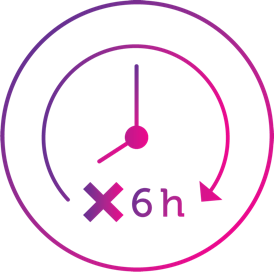Hepatotoxicity: Serious hepatic adverse reactions
occurred in 2.6% of patients treated with Retevmo. Increased
aspartate aminotransferase (AST) occurred in 51% of patients,
including Grade 3 or 4 events in 8% and increased alanine
aminotransferase (ALT) occurred in 45% of patients, including
Grade 3 or 4 events in 9%. The median time to first onset for
increased AST was 4.1 weeks (range: 5 days to 2 years) and
increased ALT was 4.1 weeks (range: 6 days to 1.5 years). Monitor
ALT and AST prior to initiating Retevmo, every 2 weeks during the
first 3 months, then monthly thereafter and as clinically
indicated. Withhold, reduce dose or permanently discontinue
Retevmo based on the severity.
Hypertension occurred in 35% of patients,
including Grade 3 hypertension in 17% and Grade 4 in one (0.1%)
patient. Overall, 4.6% had their dose interrupted and 1.3% had
their dose reduced for hypertension. Treatment-emergent
hypertension was most commonly managed with anti-hypertension
medications. Do not initiate Retevmo in patients with uncontrolled
hypertension. Optimize blood pressure prior to initiating Retevmo.
Monitor blood pressure after 1 week, at least monthly thereafter,
and as clinically indicated. Initiate or adjust anti-hypertensive
therapy as appropriate. Withhold, reduce dose, or permanently
discontinue Retevmo based on the severity.
Retevmo can cause concentration-dependent
QT interval prolongation. An increase in QTcF
interval to >500 ms was measured in 6% of patients and an increase
in the QTcF interval of at least 60 ms over baseline was measured
in 15% of patients. Retevmo has not been studied in patients with
clinically significant active cardiovascular disease or recent
myocardial infarction. Monitor patients who are at significant
risk of developing QTc prolongation, including patients with known
long QT syndromes, clinically significant bradyarrhythmias, and
severe or uncontrolled heart failure. Assess QT interval,
electrolytes and TSH at baseline and periodically during
treatment, adjusting frequency based upon risk factors including
diarrhea. Correct hypokalemia, hypomagnesemia and hypocalcemia
prior to initiating Retevmo and during treatment. Monitor the QT
interval more frequently when Retevmo is concomitantly
administered with strong and moderate CYP3A inhibitors or drugs
known to prolong QTc interval. Withhold and dose reduce or
permanently discontinue Retevmo based on the severity.
Serious, including fatal, hemorrhagic events can
occur with Retevmo. Grade ≥3 hemorrhagic events occurred in 2.3%
of patients treated with Retevmo including 3 (0.4%) patients with
fatal hemorrhagic events, including one case each of cerebral
hemorrhage, tracheostomy site hemorrhage, and hemoptysis.
Permanently discontinue Retevmo in patients with severe or
life-threatening hemorrhage.
Hypersensitivity occurred in 4.3% of patients
receiving Retevmo, including Grade 3 hypersensitivity in 1.6%. The
median time to onset was 1.7 weeks (range 6 days to 1.5 years).
Signs and symptoms of hypersensitivity included fever, rash and
arthralgias or myalgias with concurrent decreased platelets or
transaminitis. If hypersensitivity occurs, withhold Retevmo and
begin corticosteroids at a dose of 1 mg/kg prednisone (or
equivalent). Upon resolution of the event, resume Retevmo at a
reduced dose and increase the dose of Retevmo by 1 dose level each
week as tolerated until reaching the dose taken prior to onset of
hypersensitivity. Continue steroids until patient reaches target
dose and then taper. Permanently discontinue Retevmo for recurrent
hypersensitivity.
Tumor lysis syndrome (TLS) occurred in 1% of
patients with medullary thyroid carcinoma receiving Retevmo.
Patients may be at risk of TLS if they have rapidly growing
tumors, a high tumor burden, renal dysfunction, or dehydration.
Closely monitor patients at risk, consider appropriate prophylaxis
including hydration, and treat as clinically indicated.
Impaired wound healing can occur in patients who
receive drugs that inhibit the vascular endothelial growth factor
(VEGF) signaling pathway. Therefore, Retevmo has the potential to
adversely affect wound healing. Withhold Retevmo for at least 7
days prior to elective surgery. Do not administer for at least 2
weeks following major surgery and until adequate wound healing.
The safety of resumption of Retevmo after resolution of wound
healing complications has not been established.
Based on data from animal reproduction studies and its mechanism
of action, Retevmo can cause fetal harm when
administered to a pregnant woman. Administration of selpercatinib
to pregnant rats during organogenesis at maternal exposures that
were approximately equal to those observed at the recommended
human dose of 160 mg twice daily resulted in embryolethality and
malformations. Advise pregnant women of the potential risk to a
fetus. Advise females of reproductive potential and males with
female partners of reproductive potential to use effective
contraception during treatment with Retevmo and for at least 1
week after the final dose. There are no data on the presence of
selpercatinib or its metabolites in human milk or on their effects
on the breastfed child or on milk production. Because of the
potential for serious adverse reactions in breastfed children,
advise women not to breastfeed during treatment with Retevmo and
for 1 week after the final dose.
Severe adverse reactions (Grade 3-4) occurring in ≥15% of
patients who received Retevmo in LIBRETTO-001,
were hypertension (18%), prolonged QT interval (4%), diarrhea
(3.4%), dyspnea (2.3%), fatigue (2%), abdominal pain (1.9%),
hemorrhage (1.9%), headache (1.4%), rash (0.7%), constipation
(0.6%), nausea (0.6%), vomiting (0.3%), and edema (0.3%).
Serious adverse reactions occurred in 33% of
patients who received Retevmo. The most frequently reported
serious adverse reaction (in ≥ 2% of patients) was pneumonia.
Fatal adverse reactions occurred in 3% of patients;
fatal adverse reactions which occurred in >1 patient included
sepsis (n=3), cardiac arrest (n=3) and respiratory failure (n=3).
Common adverse reactions (all grades) occurring in ≥15% of
patients who received Retevmo in LIBRETTO-001,
were dry mouth (39%), diarrhea (37%), hypertension (35%), fatigue
(35%), edema (35%), rash (27%), constipation (25%), nausea (23%),
abdominal pain (23%), headache (23%), cough (18%), prolonged QT
interval (17%), dyspnea (16%), vomiting (15%), and hemorrhage
(15%).
Laboratory abnormalities (all grades; Grade 3-4) ≥20% worsening
from baseline in patients who received Retevmo in
LIBRETTO-001,
were AST increased (51%; 8%), ALT increased (45%; 9%), increased
glucose (44%; 2.2%), decreased leukocytes (43%; 1.6%), decreased
albumin (42%; 0.7%), decreased calcium (41%; 3.8%), increased
creatinine (37%; 1.0%), increased alkaline phosphatase (36%;
2.3%), decreased platelets (33%; 2.7%), increased total
cholesterol (31%; 0.1%), decreased sodium (27%; 7%), decreased
magnesium (24%; 0.6%), increased potassium (24%; 1.2%), increased
bilirubin (23%; 2.0%), and decreased glucose (22%; 0.7%).
Concomitant use of acid-reducing agents decreases
selpercatinib plasma concentrations which may reduce Retevmo
anti-tumor activity. Avoid concomitant use of proton-pump
inhibitors (PPIs), histamine-2 (H2) receptor antagonists, and
locally-acting antacids with Retevmo. If coadministration cannot
be avoided, take Retevmo with food (with a PPI) or modify its
administration time (with a H2 receptor antagonist or a
locally-acting antacid).
Concomitant use of
strong and moderate CYP3A inhibitors increases
selpercatinib plasma concentrations which may increase the risk of
Retevmo adverse reactions including QTc interval prolongation.
Avoid concomitant use of strong and moderate CYP3A inhibitors with
Retevmo. If concomitant use of a strong or moderate CYP3A
inhibitor cannot be avoided, reduce the Retevmo dosage as
recommended and monitor the QT interval with ECGs more frequently.
Concomitant use of
strong and moderate CYP3A inducers decreases
selpercatinib plasma concentrations which may reduce Retevmo
anti-tumor activity. Avoid coadministration of Retevmo with strong
and moderate CYP3A inducers.
Concomitant use of Retevmo with
CYP2C8 and CYP3A substrates increases their
plasma concentrations which may increase the risk of adverse
reactions related to these substrates. Avoid coadministration of
Retevmo with CYP2C8 and CYP3A substrates where minimal
concentration changes may lead to increased adverse reactions. If
coadministration cannot be avoided, follow recommendations for
CYP2C8 and CYP3A substrates provided in their approved product
labeling.
The safety and effectiveness of Retevmo have not been established
in pediatric patients less than 12 years of age.
The safety and effectiveness of Retevmo have been established in
pediatric patients aged 12 years and older for medullary thyroid
cancer (MTC) who require systemic therapy and for advanced
RET fusion-positive thyroid cancer who require systemic
therapy and are radioactive iodine-refractory (if radioactive
iodine is appropriate). Use of Retevmo for these indications is
supported by evidence from adequate and well-controlled studies in
adults with additional pharmacokinetic and safety data in
pediatric patients aged 12 years and older. Monitor open growth
plates in adolescent patients. Consider
interrupting or discontinuing Retevmo if abnormalities occur.
No dosage modification is recommended for patients with
mild to severe renal impairment (estimated
Glomerular Filtration Rate [eGFR] ≥15 to 89 mL/min, estimated by
Modification of Diet in Renal Disease [MDRD] equation). A
recommended dosage has not been established for patients with
end-stage renal disease.
Reduce the dose when administering Retevmo to patients with
severe hepatic impairment (total bilirubin
greater than 3 to 10 times upper limit of normal [ULN] and any
AST). No dosage modification is recommended for patients with mild
or moderate hepatic impairment. Monitor for Retevmo-related
adverse reactions in patients with hepatic impairment.
Please see full
Prescribing Information
for Retevmo.
SE HCP ISI All_25MAR2021






